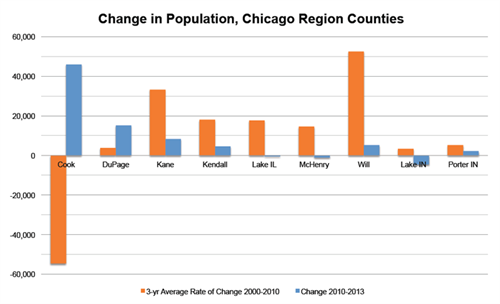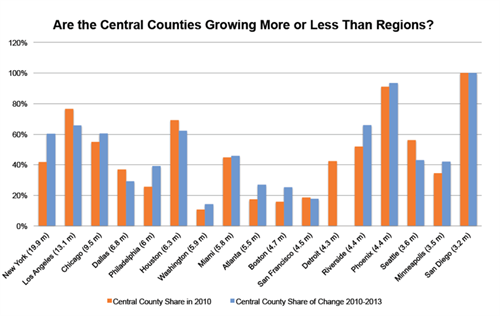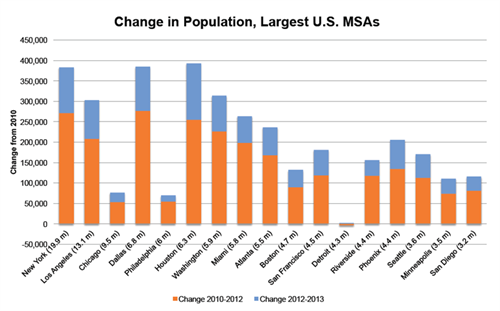
vincent desjardins (flickr)
New Census data suggests that most of the region's growth is now occurring in the core, not the suburbs.
You may have heard that Cook County is growing again. This shift has come about over the past three years, following a decade of significant decline in the core as the population of the Chicago region migrated outward. Since 2010, though, Cook County has grown by more than all the suburban counties in the region combined. What you might not know is that among the growth rates of the 17 largest U.S. metropolitan areas, Chicagoland is second to last, ahead of only Detroit—which actually lost population.
Between 2000 and 2010, Cook County lost almost 200,000 people, largely due to a very significant decline in the population of the City of Chicago. At the same time, the Chicago region’s six Illinois suburban counties—DuPage, Kane, Kendall, Lake, McHenry and Will—gained almost 500,000 new residents. In other words, the region grew quickly, but that growth was not shared with the metropolitan area’s core. These population trends were evident in the depopulation of much of Chicago’s South and West sides, the foreclosure crisis and continued greenfield construction in the exurbs.
Between 2010 and 2013, according to new data from the U.S. Census Bureau, these trends reversed—dramatically. While Cook County gained almost 50,000 people during this period, the six Illinois suburban counties increased in population by just 20,000 collectively. The two nearby Indiana counties, Lake and Porter, collectively lost more than 1,500 people during this period.

These data present a dramatic change that we must understand to plan for the future of the Chicago region. The Metropolitan Planning Council’s (MPC) initiatives in transportation policy, infrastructure financing, water supply management, suburban housing strategies and transit-oriented development are all dependent on clear-headed analysis of demographic change and future trends.
These latest Census trends suggest that there is a growing interest in living in the central sections of the Chicago region. This change follows years of declining automobile use both in the metropolitan area and in the United States as a whole, and significant growth in the Chicago central area. Indeed, the Loop and surrounding neighborhoods represent the fastest-growing downtown in the country. Thus the recent growth in Cook County may be expected. (The Census has not yet published 2013 data for the City of Chicago or individual neighborhoods.)
And these aren’t just Cook County-specific trends; across the country, the central counties of large metropolitan areas have been gaining a higher share of their regions’ total populations. Between 2010 and 2013, in the nation’s 17 largest metropolitan areas, 10 saw growth in their central counties (such as Cook County in the Chicago region) that outpaced their share of the region’s population. This was particularly true in the New York, Philadelphia, Atlanta and Boston regions. For example, in the New York region, New York City gained 60 percent of the region’s new inhabitants between 2010 and 2013 even though the city represented just a bit more than 40 percent of inhabitants in 2010.

Where Chicago is not equivalent to most other regions is its total population growth between 2010 and 2013. Over those three years, the region’s population increased by a bit more than 75,000 people, far fewer than larger metropolitan statistical areas (MSAs) like New York or Los Angeles but also less than much smaller ones like Minneapolis and San Diego. Indeed, of the nation’s 17 largest metropolitan areas, Chicago’s rate of population increase over that period (0.8%) was the second-lowest in the nation. Only the Detroit region, which actually lost population, came in lower.

The lackluster growth of the Chicago region is of great concern to MPC and to the metropolitan area’s economic vitality. The population growth trends of the past three years suggest that each of the seven counties on the Illinois side of the Chicago metropolitan area are growing far more slowly than predicted by the Chicago Metropolitan Agency for Planning (CMAP) in 2010. If the region’s counties continue to grow at levels similar to those of the most recent data, the seven-county population in 2040 will be just 9.2 million, up from 8.5 million. CMAP projected a population of 11 million, a 1.8-million-person difference. It should be noted that CMAP is in the process of updating its forecast and will have new estimates later in 2014.

Of course, any trend derived from simply examining three years of data is not adequate to forecast the future or declare failure. The Chicago region’s growth can accelerate significantly, and sound planning policies will drive that growth. MPC is working diligently across our project areas to promote sound growth in the region and improve Chicagoland’s ability to compete at the national and international levels.